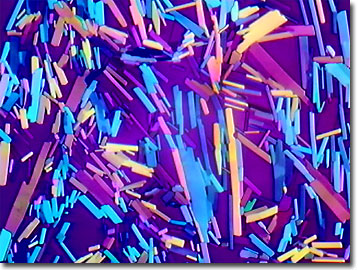Polarized Light Digital Image Gallery
Aspirin (Acetylsalicylic Acid)
Known to the pharmacist as acetylsalicylic acid, aspirin is an over-the-counter anti-inflammatory and antipyretic drug that also possesses highly effective non-opiate analgesic properties. Derived originally in nature from the bark of willows, the Greek physician Hippocrates (as in the Hippocratic Oath) used a powder extract to treat pain and reduce fever in the Fifth Century BC.

View a second image of crystallized aspirin.
As far back as 1829, salicin, the parent compound of the salicylate drug family, was isolated from willow bark. Sodium salicylate, aspirin's predecessor, was developed along with salicylic acid as a commercial pain reliever back in 1875. However, sodium salicylate had an annoying tendency to irritate the stomach lining, and in 1897, Felix Hoffman, a German chemist working for Bayer, changed the face of pharmaceuticals forever by synthesizing acetylsalicylic acid, a less acidic formulation. Soon, Hoffman's aspirin became the painkiller of choice, and Bayer still markets the wonderfully successful product.
Although it is commonly sold in grocery and convenience stores as well as pharmacies, the actual biological function of aspirin was little understood for almost a hundred years. Considering its widespread and regular use for centuries, this is quite amazing. In the 1970s, British pharmacologist Dr. John Vane finally discovered in part, how aspirin actually works. It appears that aspirin inhibits the release of prostaglandins, hormone-like substances that regulate many body functions. Prostaglandins control the elasticity of blood vessels and alter the functioning of blood platelets. Thus, aspirin can affect blood clotting and ease inflammation. Many believe that taking aspirin on a regular basis may help prevent strokes and other clot-related illnesses, but individuals should consult their physicians before adopting such a regime.
Contributing Authors
Omar Alvarado, Thomas J. Fellers and Michael W. Davidson - National High Magnetic Field Laboratory, 1800 East Paul Dirac Dr., The Florida State University, Tallahassee, Florida, 32310.
BACK TO THE POLARIZED LIGHT IMAGE GALLERY
BACK TO THE DIGITAL IMAGE GALLERIES
Questions or comments? Send us an email.
© 1995-2022 by Michael W. Davidson and The Florida State University. All Rights Reserved. No images, graphics, software, scripts, or applets may be reproduced or used in any manner without permission from the copyright holders. Use of this website means you agree to all of the Legal Terms and Conditions set forth by the owners.
This website is maintained by our
Graphics & Web Programming Team
in collaboration with Optical Microscopy at the
National High Magnetic Field Laboratory.
Last Modification Friday, Nov 13, 2015 at 02:19 PM
Access Count Since September 17, 2002: 17522
Visit the website of our partner in introductory microscopy education:
|
|
